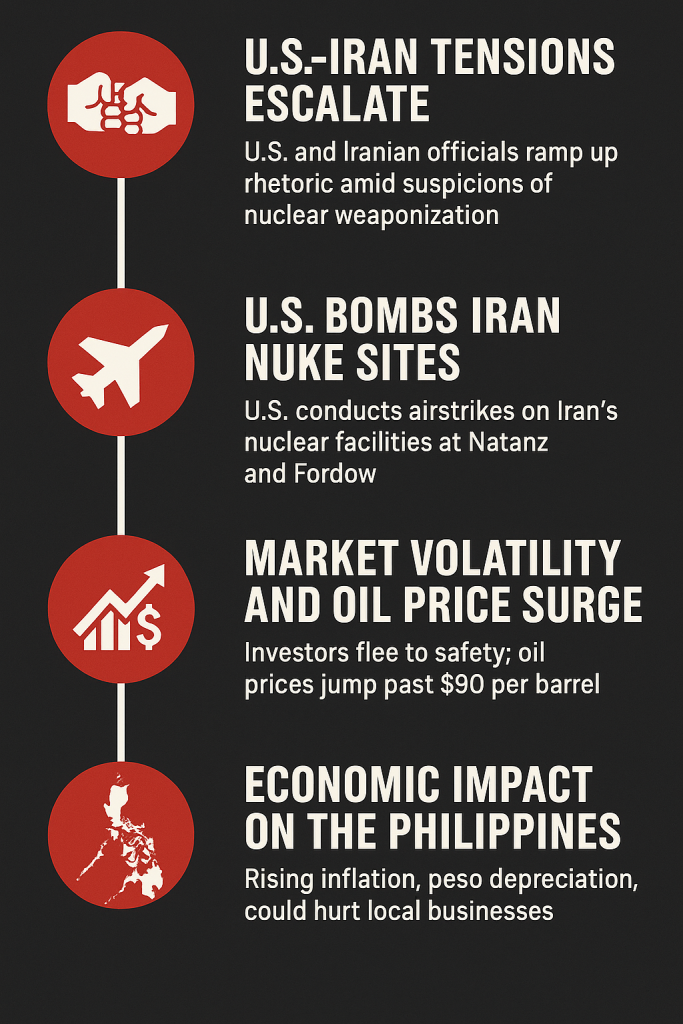June 22, 2025 — In a dramatic escalation of geopolitical tensions, the United States launched targeted airstrikes on Iran’s nuclear facilities in Natanz and Fordow. The Pentagon confirmed the operation early Saturday, describing it as a strategic attempt to degrade Iran’s nuclear development capabilities. The strikes came days after heightened rhetoric between U.S. and Iranian officials, with intelligence suggesting imminent nuclear weaponization efforts by Tehran.
Immediate Reaction and Market Volatility
The bombing triggered immediate volatility in global markets. Brent crude oil surged by over 12% in the hours following the news, touching $96 per barrel—a level not seen since mid-2023. The Strait of Hormuz, through which approximately 20% of the world’s oil supply flows, is at the center of concern. Any threat to this critical chokepoint could significantly disrupt energy supply chains globally.
Equity markets reacted with caution. The S&P 500 dipped 2.3%, while safe-haven assets such as gold and U.S. Treasuries rallied. Cryptocurrencies also experienced turbulence, with Ethereum and Bitcoin both falling by over 5% amid risk-off sentiment.
“Investors are bracing for unpredictable spillovers,” noted a report from MarketWatch. “Energy shocks tend to spark inflation, central bank recalibrations, and slower growth.”
Global Economic Implications
1. Oil Prices and Inflationary Pressure
The most immediate global impact is the surge in oil prices. Economies heavily reliant on oil imports—particularly in Asia and Europe—are expected to face increased inflation. Analysts project that if oil stabilizes above $90–100 per barrel, global inflation could rise by 0.4–0.7 percentage points in the next quarter.
2. Central Bank Policy Uncertainty
The potential for renewed inflation may delay or reverse interest rate cuts anticipated by central banks. The U.S. Federal Reserve, Bank of England, and ECB may adopt a more cautious stance on monetary easing, affecting credit availability and borrowing costs globally.
3. Disruptions in Trade and Freight
Shipping companies are already reporting increased insurance premiums for vessels passing through the Persian Gulf. Any escalation that leads to a naval blockade or further strikes would increase freight costs, particularly for energy and raw materials.
4. Investor Risk Aversion
With global investors fleeing to safer assets, capital flows to emerging markets may decline. Volatility in stock and currency markets is expected to persist as geopolitical uncertainty remains elevated.
Implications for the Philippine Economy

As a small, open economy heavily reliant on energy imports and remittances, the Philippines is vulnerable to external shocks such as this one. The following are the primary channels of impact:
A. Energy Prices and Inflation
The Philippines imports nearly all of its oil requirements, averaging 470,000 barrels per day. A $10 increase in global oil prices translates to an estimated ₱95 billion (~US$1.7 billion) in additional import costs annually. This would directly affect transportation, power generation, and food distribution costs, adding pressure to inflation, which stood at 3.6% as of May 2025.
The Bangko Sentral ng Pilipinas (BSP) may be compelled to maintain or even increase interest rates to counter inflation, at the expense of economic growth.
B. Currency and Financial Market Volatility
The Philippine peso depreciated to ₱58.60 per U.S. dollar shortly after the announcement, reflecting heightened global risk aversion. While the BSP holds over US$105 billion in gross international reserves, sustained outflows could challenge currency stability.
Stock market indices in Manila also slipped, echoing global trends, while Philippine bond yields rose amid concerns over inflation and government borrowing costs.
C. OFW Exposure and Remittances
Over 1.5 million overseas Filipino workers (OFWs) are based in the Middle East, including significant populations in Saudi Arabia, the UAE, and Qatar. Should conflict escalate regionally, OFW safety and employment may be at risk, potentially affecting the US$37 billion in annual remittances that are critical to domestic consumption and economic stability.
D. Trade and Policy Challenges
While Philippine–Iran bilateral trade is limited, the broader effects on regional trade routes and fuel procurement strategies could impact the country’s supply chain. Additionally, the Philippines must navigate its foreign policy carefully, balancing its strategic alliance with the United States with its diplomatic and economic interests in the Middle East.
| Impact Area | Global Effect | Philippine Effect |
|---|---|---|
| Oil Prices | Spike to $80–100/bbl | ₱95 bn/year extra cost, higher domestic prices |
| Inflation | Rising input prices globally | Shrinking real incomes, higher BSP rates |
| Financial Markets | Safe-haven assets outperforming risk | Peso depreciation, remittance concentration risks |
| Supply Chains | Insurance/shipment cost rises | Import cost and goods delays |
| Geo-political risk | Longer-term uncertainty | Policy complexity in balancing relations & trade |
Impact on Philippine SMEs and How to Respond
Small and medium businesses in the Philippines are likely to feel the effects of rising oil prices, higher transportation costs, and more expensive imported goods. This will especially affect industries like food delivery, logistics, manufacturing, and retail. As everyday costs go up, many consumers may cut back on spending, which could hurt sales for local businesses.
To cope with these challenges, SMEs should take steps to reduce costs and protect their cash flow. This can include saving on fuel and electricity, finding alternative suppliers, or reviewing delivery routes. Building up a financial cushion—such as setting aside emergency funds or applying for affordable credit—can also help businesses manage through tough months.
Going digital can also make a big difference. Using online tools for sales, inventory, and customer service can improve efficiency and open new markets. Finally, businesses should stay informed about government programs or support that may be available to help them adjust. With smart planning and flexibility, SMEs can stay competitive even during uncertain times.





